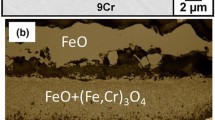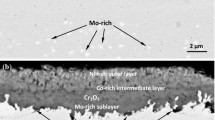Abstract
Difficulties of alloy selection for high-temperature halogen service are described with reference to product morphologies, vaporization and the manner by which alloy degradation may occur. Selected results from work with alloy 600 (Ni-16 Cr-8Fe) and Havnes® Alloy 230 (Ni-22 Cr-14W-2Mo-0.3Al-0.02 La) are used to contrast various modes of attack. Oxidizing chlorine-containing gases often give rise to heavy volatilization and intergranular attack at 900°C (1650°F) whilst HF/steam mixtures result in more uniform internal oxidation at 750°C (1380°F).
Similar content being viewed by others
References
P.L. Daniel and R. A. Rapp, “Halogen Corrosion of Metals,” Adv. in Corr. Science and Tech., 5 (1976), p. 55–172.
P. Elliott, A.A. Ansari and R. Nabavi, “High Temperature Corrosion in Halogenation, Oxy-Halogenation and Oxidizing Environments,” Presented to AIME/ASM Symposium on “High Temp. Corrosion in Energy Systems,” Detroit, September 1984, in press.
Y.K. Li and R.A. Rapp, “Internal Chlondation of Dilute Ni-Cr Alloys,” Met Trans., 14B (1983), p. 509–510.
S.N.S. Reddy and R.A. Rapp, “Internal Fluoridation of Ni 5.6% Cr Alloy,” Met. Trans., 11B (1980), p. 533–534.
P. Elliott, A.A, Ansari and G. Marsh, “Aspects of High-Temperature Halogen Corrosion by HCl-containing Atmospheres at 800°C,” Intl. Congress on Metallic Corrosion, Toronto, 3, June (1984), p. 330–335.
P. Elliott, A.A. Ansari, R. Prescott and M.F. Rothman, “Behaviour of Selected Commercial-Base Alloys during High-Temperature Oxychlorination,” Paper 13, NACE: CORROSION 85, Boston USA, March 1985.
G. Marsh, “The High Temperature Corrosion of Ni-Alloys in Hydrogen Fluoride-Containing Environments,” Ph.D Thesis, University of Manchester, 1982.
G. Marsh and P. Elliott, “The High Temperature Corrosion of Ni-Cr Alloys in HF-containing Atmospheres,” Presented to AIME/ASM Symp. (See ref. 2), Detroit, September 1984, in press.
S. Baranow, G.Y. Lai, M.F. Rothman, J.M. Oh, M.J. McNallen and M.H. Rhee, “Materials Performance in High-Temperature, Halogen-Bearing Environments,” Paper 16, NACE: CORROSION 84, New Orleans, USA, April 1984.
C.J. Tyreman, “Aspects of High Temperature Oxidation and Fluoridation of Nickel-base Alloys,” M.Sc Dissertation, University of Manchester, October 1983.
W.Z. Friend, “Corrosion of Nickel and Nickel-Base Alloys,” Corrosion Monograph Series, Wiley-Interscience Pubi., 1980.
C.J. Tyreman — current Ph.D studies. University of Manchester, England, UK.
R. Prescott — current Ph.D studies. University of Manchester, England, UK.
G.Y. Lai, Private communication, Cabot Corporation, USA.
G.Y. Lai, M.F. Rothman, S. Baranow and R.B. Herchenroeder, “Recuperator Alloys for High-Temperature Waste Heat Recovery,” J. of Metals, 35 (1983), p. 24–29.
R.C. Lobb, “Observations on the Microstructure of 20 Cr 25 Ni — Nb Stainless Steel after Exposure to Iodine Vapour during Creep at 750°C,” Oxid. of Metals, 15 (1981), p. 147–167.
M.E. El Dahshan, J. Stringer and D.P. Whittle, “Effect of Carbon on Hot Corrosion of Cobalt-Base Alloys,” Cobalt, 57 (1972), p. 182–191, 201.
A.J.B. Cutler, W.D. Halstead, J.W. Laxton and C.G. Stevens, “The Role of Chloride in the Corrosion Caused by Flue Gases and Their Deposits,” ASME Annual Meeting, Paper 70, WA/CD-1, 1970.
R.J. Fruehan and L.J. Martonik, “The Rate of Chlorination of Metals and Oxides” Part III: “The Rate of Chlorination of Fe2O3 and NiO in Cl2 and HCl,” Met. Trans. 4 (1973), p. 2793.
Y. Ihara, H. Ohgame, K. Sakiyama and K. Hashimoto, “Corrosion Behaviour or Iron in HCl2 and Gas Mixtures of HCl2 and O2 at High Temperature,” Corrosion Science, 21 (1981), p. 805–817.
P. Mayer and A.V. Manolescu, “Influence of Hydrogen Chloride on Corrosion of Boiler Steels in Synthetic Flue Gas,” Corrosion 36 (1980), p. 369–373.
Additional information
Peter Elliott is currently a Lecturer in corrosion science and engineering at the Corrosion and Protection Centre, UMIST, in Manchester, England
R. Prescott and C.J. Tyreman are each researching for their Ph.D. degrees at the Corrosion and Protection Centre, UMIST, Manchester, England
Rights and permissions
About this article
Cite this article
Elliott, P., Tyreman, C.J. & Prescott, R. High Temperature Alloy Corrosion by Halogens. JOM 37, 20–23 (1985). https://doi.org/10.1007/BF03259691
Published:
Issue Date:
DOI: https://doi.org/10.1007/BF03259691




